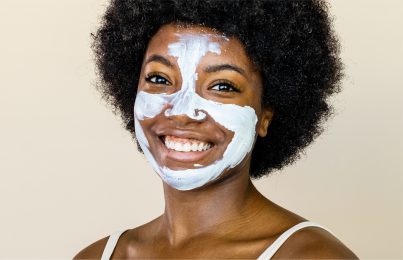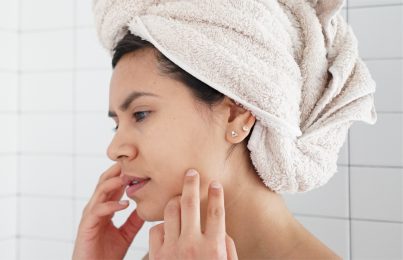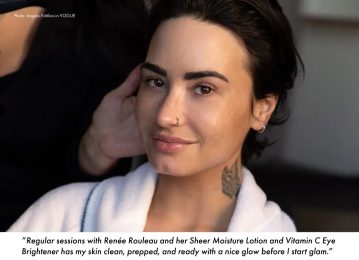When I started seeing clients as an esthetician back in 1989, I worked at a salon that used a high-frequency machine. Part of my training was learning how to use it and after seeing the RESULTS it gave, I’ve been a fan of this technology ever since. Back then, it was only used in professional settings and wasn’t a device you could get at home. Now, that’s no longer the case! While at-home devices are often weaker or less effective than their professional counterparts, the high-frequency devices you can buy now are just like the ones used in facial rooms or med spas.
- What is a High-Frequency Machine, and How Does It Work?
- Which Color of Light Should I Use?
- How to Treat a Pimple Using High Frequency (A.k.a. the “Sparking” Method)
- How to Prevent Breakouts Using High Frequency
- Is There Anyone Who Should Not Use High Frequency For Breakouts?
- Why You Should NEVER Use High Frequency With an Alcohol-Based Product
If you get regular breakouts, this device can definitely be a great tool to have in your arsenal. That said, I have to let you know that it might not be for everyone. In this post, I’ll share how I have used the high-frequency machine on my own skin and with clients to help get rid of blemishes fast and potentially prevent new ones from forming — as well as how to avoid damaging your skin.
What is a High-Frequency Machine, and How Does It Work?
The high-frequency machine is an at-home device originally used exclusively by professionals. When used correctly, it can help blemishes go away faster and perhaps prevent new ones from forming.
Fun fact: high-frequency currents were first discovered by Nikola Tesla in the late 1800s. He channeled these currents to produce ozone, which has powerful antibacterial and antiseptic properties. This was used to treat infections such as strep throat. Pretty cool, right?
This concept, pioneered by Tesla, is also what makes high frequency effective against acne—an infection caused by P. acnes bacteria. Using small electrical currents, the high-frequency machine gives off ozone (the O3 version of oxygen). Because bacteria can’t survive in an oxygen-rich environment, high frequency can help to eliminate P. acnes and improve breakouts faster. (And that’s what we all want, right?)
Most high-frequency devices come with multiple wand attachments, but I generally only use two of them (more on that later).
Which Color of Light Should I Use?
If you’re using your high-frequency device to treat or prevent blemishes, you must look for one that gives off violet light (also known as argon).
Some devices use orange light (known as neon), but this is used for anti-aging purposes and won’t be effective against acne.
How to Treat a Pimple Using High Frequency (A.k.a. the “Sparking” Method)
The method used to target individual blemishes using high frequency is also called “sparking” (you’ll see why in a minute!). Here are a few important tips to make sure you’re getting the most out of your device without damaging your skin.
What kind of pimple should it be used on?
A high-frequency device should ONLY be used on blemishes that are red, painful, and sore to the touch. If you try to use it on clogged pores or the marks left behind by breakouts, you won’t have any luck. It must be used on an active blemish.
In the first half of the video below, I demonstrate the sparking method on a huge, painful chin pimple I had. It started out as a deep cyst but by the time I filmed this video, it was starting to surface as a whitehead. I was also faithfully using my Anti Bump Solution on the blemish every night, which definitely helped cut the healing time in half.
The method—how to “spark”
- Start with clean skin and choose the smallest, rounded attachment. This attachment is small and can really put the focus on a blemish and not the skin around it.
- Apply a water-based conducting gel, like Skin Correcting Serum, over the blemish. (Some people like to use liquid toners or even just water, but I prefer a gel-type consistency since it does a better job of coating the skin and doesn’t evaporate.)
- Turn the device up to about ¾ strength. Turning it up too high is too aggressive. (A little goes a long way.)
- Place it directly over the blemish, making contact with the skin. You can feel it “zapping” you, like a quick shock but it’s not really painful.
- Hold the device in place on the active blemish for 3 seconds
- Release for one second
- Repeat this process 4 times (the device should make contact with your skin for 12 seconds total)
- Do this once a day until the blemish is no longer sore. I also apply Anti Bump Solution nightly until the blemish is no longer red.
The biggest mistakes people make when using high frequency
The sparking method should only be used on a pimple ONCE a day. What a lot of people don’t understand is that the high-frequency device actually emits a little bit of UV light. It’s important to know that UV light triggers discoloration by overstimulating pigment cells. This means that it could make post-blemish marks worse by keeping fussy pigment cells active. It’s so important not to use this device more often than directed. Otherwise, you risk skin discoloration which is not in line with achieving clear, even-toned skin.
Another way to avoid inadvertently damaging your skin is to stop “sparking” a blemish once it’s no longer sore to the touch. After it’s past this stage, I believe the device will do more harm than good because the truth is, a blemish will generally last or 5-7 days but the discolored mark leftover can linger for weeks or months.
How to Prevent Breakouts Using High Frequency
In addition to using the high-frequency device to clear individual blemishes, you can use it to potentially help prevent new ones from forming.
The Method
- Start with clean skin and select the flat “mushroom” head attachment.
- Apply your conducting gel all over the face or just to the areas you’re treating (for example, a common area for breakouts is the chin and jawline area).
- Place the attachment directly onto your skin and gently drag it across the areas you want to treat.
- Do this for 3 minutes, and keep the device constantly moving (while in direct contact with the skin) so you don’t linger on one spot.
- This should be done once a week. This is NOT a device I recommend for daily use for prevention.
*Note: If you’ve already used the “sparking” method on an individual blemish that day, avoid the area. You don’t want to go over it twice in one day!
Is There Anyone Who Should Not Use High Frequency For Breakouts?
Yes. While this device can be really effective, it could also be negatively affecting the skin when used incorrectly or too often. As I mentioned before, it gives off a bit of UV light. This can overstimulate pigment cells and make the dark marks left behind by blemishes worse.
There are two groups of people I would say need to be cautious about using a high-frequency device:
- Those prone to hyperpigmentation. If the dark marks left behind by acne are a bigger concern for you than acne itself, proceed with caution. This is especially true if you have a deeper skin tone since this makes you more prone to hyperpigmentation which is already an issue or deeper skin tones. This doesn’t mean you need to skip the device altogether, but you will have to be extremely diligent about using it correctly. You might also consider getting it done by a trained professional (like an esthetician) to minimize risk. That said, if you choose not to use this device, that’s fine too! There are plenty of other ways to treat blemishes.
- Those who over fixate. If you get overzealous about skincare and have a hard time controlling behaviors like skin picking (the more is better attitude!), this device may not be for you. Trust me when I say, more is NOT better and if you don’t trust yourself to use the device as directed, you’re better off skipping this one.
Why You Should NEVER Use High Frequency With an Alcohol-Based Product
Years ago, I worked with an esthetician who applied an alcohol-based toner to a client’s skin before using high frequency on them (this was back in the late 80s when alcohol-based toners were super popular). Because the high-frequency device uses an electrical current, it actually lit the alcohol on fire and a flame shot across the client’s skin! Needless to say, if you use a liquid medium for conducting, make sure it’s free of solvent, drying alcohols like SD alcohol 40. There are “good” alcohols like cetyl alcohol that won’t cause a bad reaction.
Lastly, the high-frequency machine really is a great device for acne, but one final thought I’d like to share is that it’s important to manage your expectations. Acne is a disease of the skin for which there is no real known cure, meaning no one thing will be able to get rid of it completely (high frequency included). Remember that managing acne requires a consistent, well-rounded approach! If you’re not sure where to start or want to make sure you’re on the right path, book a virtual consultation with our in-house esthetician to get the best personalized anti-acne routine for you.
I hope you found this information helpful and will follow my expert advice should you choose to purchase one for use at home.
Celebrity Esthetician & Skincare Expert
As an esthetician trained in cosmetic chemistry, Renée Rouleau has spent 30 years researching skin, educating her audience, and building an award-winning line of products. Her hands-on experience as an esthetician and trusted skin care expert has created a real-world solution — products that are formulated for nine different types of skin so your face will get exactly what it needs to look and feel its best. Trusted by celebrities, editors, bloggers, and skincare obsessives around the globe, her vast real-world knowledge and constant research are why Marie Claire calls her “the most passionate skin practitioner we know.”




Comments:
Hi! I have the Portable High Frequency JHM-08A w the pinkish light & I was wondering if this light helps with wrinkles, (crows feet) & tightening of the skin? Also, does it help with brown/dark spots on the face & of so, do I still hold the wand on the spot for 3 seconds? I just don’t want to make them worse.
Posted By: Aryan |
Excellent question, I’m not familiar with this particular model, but you want to use the orange light (known as neon) for anti-aging purposes. Because the high-frequency devices give off a bit of UV light, this can overstimulate pigment cells and make the dark marks worse. For dark spots, fine lines, and loss of elasticity, I recommend checking out the Advanced Resurfacing Serum. Hope this helps!
Posted By: Renée Rouleau |
Aloha,
I have acne & melasma. Should I not use a high frequency machine like this one all over my skin due to my tendency to hyperpigment and have melasma? I’ve been using my device daily & all over my skin for prevention of acne. I feel like my melasma is worse and I’m betting this is why.
Do you think it could have helped my melasma spread?
Thank you!
Posted By: Andrea Robles |
Hello there! It is important if you are struggling with discoloration to only use the high-frequency device on active breakouts once a day. A high-frequency device actually emits a little bit of UV light. It’s important to know that UV light triggers discoloration by overstimulating pigment cells.
Posted By: Renée Rouleau |
Can you please tell me which specific device you’re using in this video? Thanks!
Posted By: Jane Amschwand |
Yes! It’s this one: https://www.amazon.com/High-Frequency-Darsonval-NEW-SPA/dp/B005851HJU/ref=sr_1_13_s_it?s=beauty&ie=UTF8&qid=1488151665&sr=1-13&keywords=high+frequency+facial+machine&pldnSite=1
Posted By: Renée Rouleau |
Hi Renee, thank you for all this information! The high frequency device you linked seems to have a range of mixed reviews on Amazon. In your experience, does this brand device work well? If you have another high frequency device you use and suggest, could you share that as well?
Thanks!!
Posted By: Meredith Nappa |
Hi! This is the only high-frequency device I have used recently. There are a lot of good options out there, just be sure to choose one from a reputable brand and one that comes with the small rounded tip and the flat tip.
Posted By: Renée Rouleau |